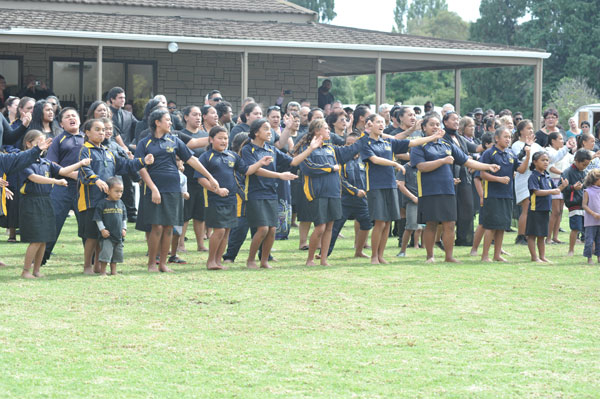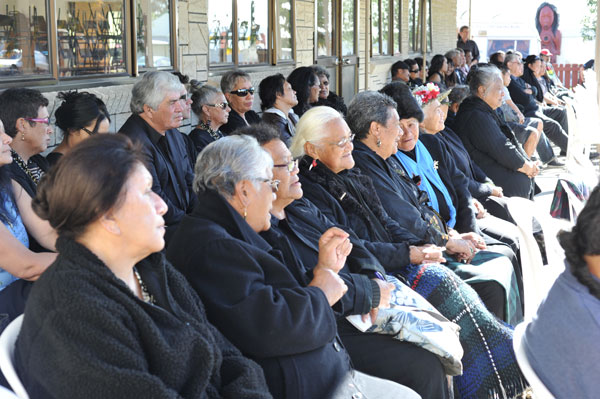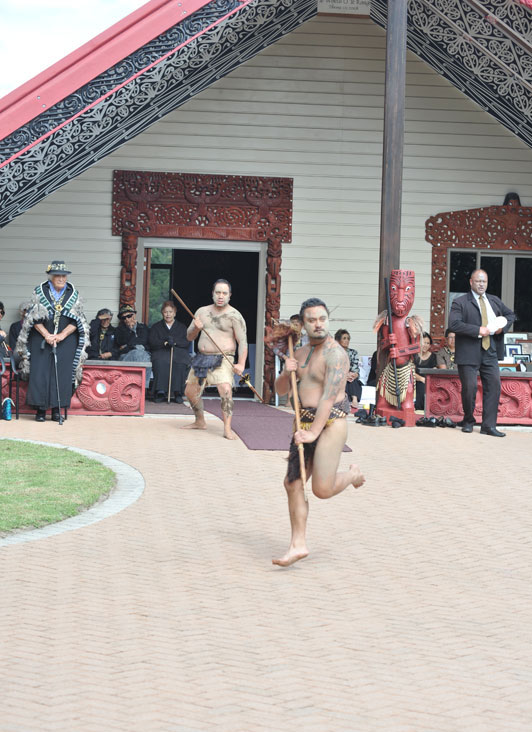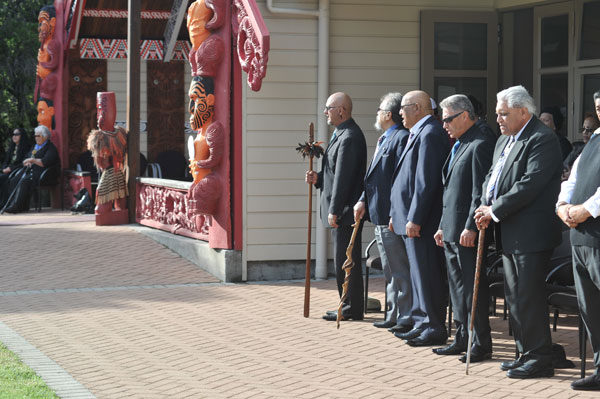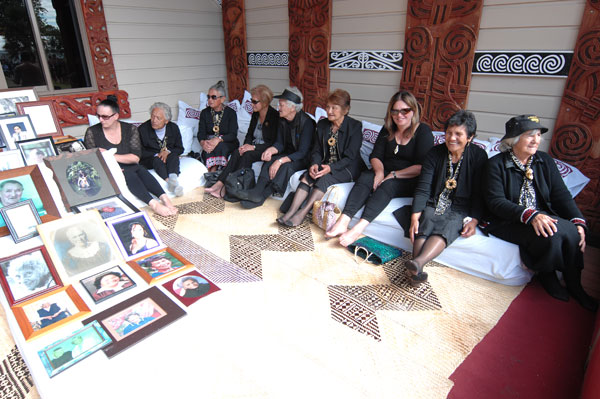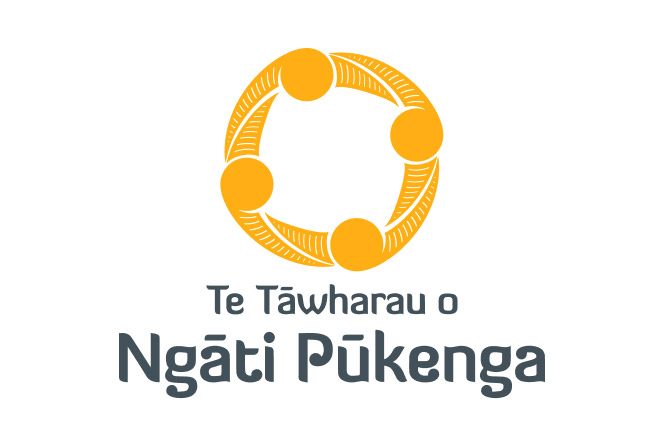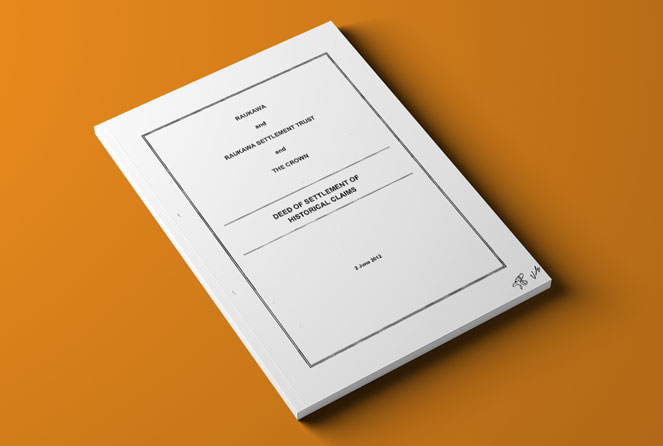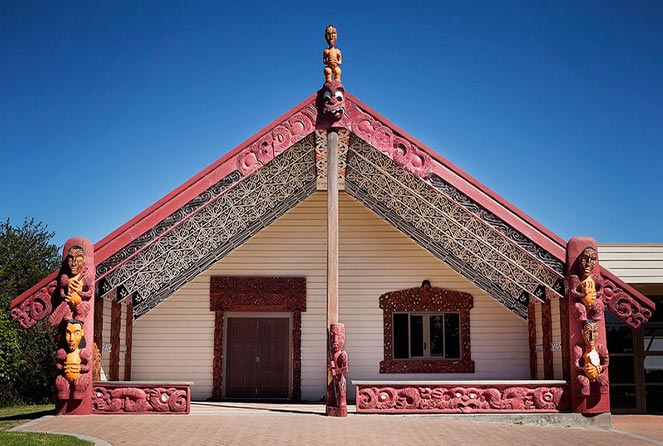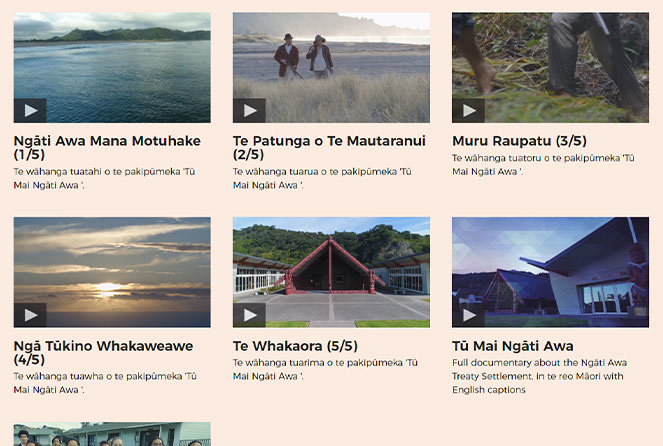Ngāti Pūkenga

Video transcript
[Sound of flute.]
(Welcome screen with the logos of Te Tāwharau o Ngāti Pūkenga and Manatū Taonga Ministry for Culture & Heritage. Aligned left on the screen are written the words ‘Te Tai Whakaea Treaty Settlement Stories Ngāti Pūkenga’.)
[Background music starts.]
(Video cuts to a view of trees in a forest.)
(Video cuts to a ground-level drone shot approaching the entrance of a marae meeting house.)
(Video cuts to a drone aerial view of a harbour inlet with open ocean and dome-shaped mountain visible in the background.)
(Video cuts to Speaker 1.)
Speaker 1: “Piki ake a Tāwhaki i te arakuiti. I whakatauira ai te ara a Rangi, te ara a Tūkaiteuru.”
(When Speaker 1 says ‘ka kakea te ara whāiti…’ the video cuts to drone aerial view above a coastline and harbour inlet.)
“Ka kakea te ara whāiti, ka kakea te ara whārahi.”
(When Speaker 1 says ‘ko te ara I whakatauira ai…’ the video cuts to drone aerial view above a sealed road winding along the side of a harbour inlet.)
“Ko te ara i whakatauira ai tō tupuna.”
(When Speaker 1 says ‘…ko te ao roroa…’ the video cuts to drone aerial view above a stream and adjacent area of swamp.)
“Ko te ao nunui, ko te ao roroa, ko te ao whiti te rā. Tēnā ka eke.”
(When Speaker 1 says ‘…kei ō mana i runga…’ the video cuts to drone aerial view above a harbour inlet filled with sandbars looking out to sea.)
(When Speaker 1 says ‘…kei ō ariki…’ the video cuts to drone aerial view of rows of commercial mussel beds in the sea in front of green hills.)
(When Speaker 1 says ‘…kei ō taura…’ the video cuts to drone aerial view of coastline in shade at sunset.)
“Kei tō ihi, kei tō mana, kei ō mana i runga, kei ō ariki, kei ō tapairu, kei ō pūkenga, kei ō wānanga, kei ō taura, kei ō tauira. Tūturu whakamaua kia tina. Tina! Haumie, hui e. Taiki e!”
(Video cuts to Speaker 1 sitting facing the camera. The words ‘Ngāti Pūkenga ki Manaia’ appear followed by ‘Haerengārangi Mikaere’ in a yellow box at the bottom of the screen before disappearing from the screen.)
(Video cuts to a drone aerial view across the top of a red-roofed building to the grass lawn in front of it.)
(Video cuts to a drone ground-level view moving through the entrance to a marae and over a wharenui meeting house.)
(Video cuts to a drone aerial view of 30-40 people gathered on the grass in front of a wharenui meeting house with the name ‘Te Kouorehua’ visible beside the door.)
(Video cuts to Speaker 2. The words ‘Ngāti Pūkenga ki Ngāpeke’ appear followed by ‘Rāhera Ohia’ in a yellow box at the top of the screen before disappearing from the screen.)
Rāhera Ohia: “I think of us as highly educated people. Which probably overall might be true. I don’t know. You know I’m not sure if higher education should be rated quite so highly but, you know. But I think that’s one of the, another thing we’re known for. But I think… I’m… I think more than anything we’re known as people of honour and people of integrity.”
Interviewer: “That’s a great way to wrap up but I’ve still got two questions.”
[Sound of laughter.]
[Sound of birds and running water].
(Video cuts to drone aerial view moving above stream, mangrove forest, houses, and rolling hills.)
[Voice of Speaker 3 is heard.]
(After Speaker 3 says ‘…when the chief from Waharoa…’, the video cuts to drone aerial view of the side of a tree-covered hill.)
Speaker 3: “One of our main proverbs from around here. When I think the chief from Waharoa come through and he saw these, you know, all the, all of the Ngāti Pūkenga, all of the whānau around the sandbank you know, eating. Thought they were eating you know; they were picking up these mud snails and having a feast.”
(After Speaker 3 says ‘…picking up these mud snails and having kai”, the video cuts to Speaker 3.)
Speaker 3: “When resources are scarce, the people become as taniwha. Hamuti wera, niho tetē. In terms of Ngāti Pūkenga, growing up in my time at Ngāpeke there wasn't a, well, I don't remember a lot of kōrero about Ngāti Pūkenga”
(After Speaker 3 says ‘…in terms of Ngāti Pūkenga…’, the video cuts to two people sitting at a table.)
(Video cuts to Speaker 3. The words ‘Ngāti Pūkenga ki Ngāpeke’ appear followed by ‘Rehua Smallman’ in a yellow box before disappearing from the screen.)
Rehua Smallman: “Quite honestly. And whilst we weren't… We never really... In terms of my time growing up we never really spoke about you know, differences of iwi or, I think we just spoke about Ngāi Te Rangi. Cause I think at the time you know, a lot of our people were of the understanding that we were Ngāi Te Rangi.”
(After Rehua Smallman says ‘…a lot of our people…’, the video cuts to a person sitting at a table talking and gesturing with their hands.)
Rehua Smallman: “We were a hapū of Ngāi Te Rangi. And I always remember my dad actually and then he always used to say that our kui, Merataka used to you know, always used to say that Ngāti Pūkenga was an iwi and not a hapū.”
(After Rehua Smallman says ‘…he would use to say…’, the video cuts back to Rehua Smallman speaking to the camera.)
Rehua Smallman: “That was her kōrero all the time. But yeah, but we grew up you know, under the idea that Ngāti Pūkenga was a hapū of Ngāi Te Rangi.”
(After Rehua Smallman says ‘…Ngāti Pūkenga was a hapu of Ngāti Rangi’, the video cuts to drone aerial view moving over rolling green hills toward the sea.)
(Video cuts to drone aerial view of bush-covered hills.)
(Video cuts to Speaker 4. The words ‘Ngāti Pūkenga ki Manaia’ appear followed by ‘Shane Ashby’ in a yellow box before disappearing from the screen.)
Shane Ashby: “Pūkenga. I can understand when I asked my mother the question and she answered, I don’t know. I can understand her confusion and her generation's confusion. As I continued into the research and went on a path of going to talk with our elders, it was really clear that even they didn't fully understand who Ngāti Pūkenga were.”
(After Shane Ashby says ‘…even they didn’t fully understand who Ngāti Pūkenga were…’, the video cuts to different views of a person sitting on the floor reading a piece of paper.)
Shane Ashby: “One of our beautiful, old kuia Aunty Bonnie Renata. I remember sitting and talking with her and she looked at me and she asked me, ‘Boy, who’s Ngāti Pūkenga? Because we've never heard that name, I've never heard that name. The only name that was ever spoken in Manaia was Ngāti Kiore Kino. I've never heard Ngāti Pūkenga until recent times.’”
(After Shane Ashby says ‘…because we’ve never heard that name…’, the video cuts back to Shane speaking to the camera.)
Shane Ashby: “Which was really interesting. But an understandable dynamic. Te Tāwera. Another name for our people. No one had heard of that. It was a name that was long lost. But yet the minute books were full of the name, Te Tāwera. So, ask me who Ngāti Pūkenga are today. We're the combination of three very important ancestors. Pūkenga of course, from Mātaatua. These are our direct lines. The convergence between Ngāti Pūkenga ancestors and that of Kūmaramāoa of the Waitaha tribe saw the eventuation of Te Tāwera. That appellation, that name being put on sections of the Ngāti Pūkenga. Particularly, those that were living at Maketū at the time. And then of course, the third whakapapa link well, line is that of Horouta. Through Rongowhakaata and his son, Rongopopoia. So, between Rongopopoia, Kūmaramāoa and Pūkenga. That's who Ngāti Pūkenga are today. And we can all, hand on heart say we are all descended from there.”
(After Shane Ashby says ‘…we are all descendant from there’, the video cuts to drone aerial view moving over bush-covered hills next to the sea.)
(Video cuts to Speaker 5. The words ‘Ngāti Pūkenga ki Pakikaikutu’ appear followed by ‘Hori Parata” in a yellow box before disappearing from the screen.)
Hori Parata: “Well, what I heard was back there when Moeroa and his war party came up here to the Bay of Islands to get some guns.”
(After Hori Parata says ‘…get some guns’, the video cuts to drone aerial view of coastal headland and beaches.)
Hori Parata: “Now they'd say on the way up here that, boy wanted to come in and meet his...see his sister who had been captured by Ngāpuhi down there in Tauranga, I think it was.”
(After Hori Parata says ‘…in Tauranga I think’, the video cuts to exterior of building with the words ‘Tamaterau Hall For Hire’ fixed to the wall.)
Hori Parata: “And he got caught there at Tamaterau. He was killed by those people that were in Whāngārei at that time.”
(After Hori Parata says ‘…those people at Whangārei at the time’, the video cuts to view of tennis court.)
Hori Parata: “From Marupō. Oh, what I meant is that's what was happening back in those days.”
Interviewer: “Yeah.”
(After Hori Parata says ‘…what I meant is that’s what was happening...’, the video cuts to Hori speaking to the camera.)
Hori Parata: “And obviously, I suppose, I mean that, that's how it was in those days, ay. Our people are watching all the time ay. Oh, well they would've known that you got to come off that, off that waka.”
(After Hori Parata says ‘…off that waka’, the video cuts to view of a wharf with boats and the sea in the background.)
Hori Parata: “And Tirarau and those fullas. Iwitahi. While staying there, I heard that Moeroa died there. But the two that were given wives by Ngāti Hine was Whatarau and Tiketike.”
(After Hori Parata says ‘…but the two that were given wives…’, the video cuts to Hori sitting facing the camera.)
Hori Parata: “But they did, they did support the pakanga at Ruapekapeka.”
(After Hori Parata says ‘…at Ruapekapeka’, the video cuts to drone aerial view moving above stream, mangrove forest, houses, and rolling hills.)
(Video cuts to Speaker 6 in front of wharenui meeting house. The words ‘Ngāti Pūkenga ki Ngāpeke’ appear followed by ‘Te Harawira Ohia’ in a yellow box before disappearing from the screen.)
Te Harawira Ohia: “I like to reference Pūkenga as, well especially our tauā, in terms of the stories, Ngā Matā-kai-kutu-kurī. So Ngā Matā-kai-kutu-kurī is, we were known as hired dogs. Hired mercenaries. So if anyone needed help, they called on Pūkenga. And Ngā Pōtiki, us or these ones, especially us down in Ngāpeke, the Ngā Pōtiki lot were known as fighting in the water.”
(After Te Harawira Ohia says ‘…us or these ones…’, the video cuts to a drone aerial view over the top of a red-roofed building to the grass lawn in front of it.)
Te Harawira Ohia: “So, we never used to fight on the land. We used to fight within the water and used to slaughter everyone in the water down in the mudflats and in the estuary. Oh, you know. Where all the mangroves and all of that are.”
(After Te Harawira Ohia says ‘…where the mangroves are’, the video cuts back to the Te Harawira speaking in front of a meeting house.)
Te Harawira Ohia: “And so that's one thing I like to put forward for, especially us young ones when we're going into hakas or you know, rugby. Hitting the field is just remembering that Ngā Matā-kai-kutu-kurī o Ngāti Pūkenga. We're the hired dogs, executioners pretty much. That's how I like to call it.”
(After Te Harawira Ohia says ‘…is how I like to call it’, the video cuts to drone aerial view of a boat moving across the sea.)
(The video cuts to Speaker 1, Haerengārangi Mikaere, sitting in a chair.)
Haerengārangi Mikaere: “Manaia has always been well-known by its guests for the food basket.”
(After Haerengārangi Mikaere says ‘…for the kāpata kai…”, the video cuts to drone aerial view moving over a hilly coastal headland toward the sea at sunset.)
Haerengārangi Mikaere: “And I know during my time and also today our people are still heavily supportive of the whole kāpata kai process. And work really hard at maintaining the fertility of that resource available to our people, going forward.”
(After Haerengārangi Mikaere says ‘…the resource available to our people…’, the video cuts to Haerengārangi speaking to the camera.)
Haerengārangi Mikaere: “So that our grandchildren can still tell what a crayfish looks like. In some areas throughout Aotearoa now that's gone. From those islands of the past. And we certainly don't want that happening to Manaia. Although, I must say it's going to take a lot more work.”
(Video cuts to drone aerial view moving up and away from a marae.)
(Video cuts to Speaker 7. The words ‘Ngāti Pūkenga ki Maketu’ appear followed by ‘Mereana Moko’ in a yellow box before disappearing from the screen.)
Mereana Moko: “Yeah, the Kaikokopu is our awa. As a pepeha as such, we don't sort of have your generic pepeha with your maunga and your awa. Oh well, we've got an awa. We don't have a specific maunga. But there's no questioning our presence or our survival off the Kaikokopu River. So, it starts in Tāheke, which is near Ōkere Falls. There's a marae over there, Tāheke. Not far from there the Kaikokopu starts there. Travels through Paengaroa lands and Maniatūtū and then comes through to the back of Waewaetūtuki and finishes at the Waihī estuary.”
(After Mereana Moko says ‘…it travels through Paengaroa lands and Mangatutu…’, the video cuts to a drone aerial view moving down a stream toward a tidal estuary.)
Mereana Moko: “That's our, I suppose been a stable source of pātaka for us through our existence in Maketū. We've always lived alongside it; from the time we arrived to today.”
Interviewer: “Yeah.”
Mereana Moko: “So yeah, it's a, yeah, Kaikokopu. The name given because it's the amount of kōkopu that are abundant, well was abundant in that river.”
Interviewer: “Right.”
Mereana Moko: “And that travelled all the way up through into Rotorua to spawn. So yeah, that's our river.”
(After Mereana Moko says ‘…that’s our awa…’, the video cuts to Mereana speaking to the camera.)
Mereana Moko: “From our… Waewaetūtuki is a stronghold of our whenua in Maketū.”
Interviewer: “Yeah.”
Mereana Moko: “I suppose… It's really hard to describe the area of Waewaetūtuki but it sits between Paengaroa, Pungakawa and Maketū township as we know it. Those are our neighbours. The area, I suppose the general area in between it is known as Waewaetūtuki.”
(After Mereana Moko says ‘…Maketu township…’, the video cuts to drone aerial view moving across tidal estuary towards headland and small group of houses.)
(Video cuts to drone aerial view above a sealed road winding along the side of a harbour inlet.)
(Video transition to Speaker 5, Hori Parata speaking to the camera.)
Hori Parata: “Kiore would have been a big kai here, amongst our people. We don't… The kiore is not a rat.”
Interviewer: “Yeah.”
Hori Parata: “Rather it is a kiore.”
Interviewer: “Oh, it is a kiore?”
Hori Parata: “Yes, yes, yes. Here's the difference of the kiore to a Pākehā rat. It doesn't have that vector like the Pākehā rats got that flea, that'll bite you and make you sick.”
Interviewer: “Right.”
Hori Parata: “That's the first thing. Only lives for 12 months. Thirdly, that's what the...You know, three mammals came here, humans, kurī and kiore. The humans and kurī are mixed. But the kiore was still pure blood from Hawaiki. Right up to today.”
Interviewer: “Far out.”
Hori Parata: “No sign at all of any add mix with the two Pākehā rats or the mouse. That's unique, man.”
Interviewer: “Yeah.”
(After Hori Parata says ‘…that’s unique man’, the video cuts to views across a shell-covered beach out to sea, and within a forest of trees.)
Hori Parata: “Well, a lot of our people that you know, they let the Pākehā tell them it's just a rat.”
Interviewer: “Yeah.”
Hori Parata: “Ay?”
Interviewer: “Yeah.”
Hori Parata: “It wasn't sexy in those days you know, to be eating rats. And yet, it was a delicacy. You know, you didn't eat them like a pipi. You know, it was special ay. Special events. You know, after receiving your puhoro maybe you wanna have a feed of some kiore.”
(After Hori Parata says ‘…special kaupapa…’, the video cuts to Speaker 5, Hori Parata speaking to the camera.)
(Video cuts to drone aerial view over the top of a tree-covered hill.)
(Voice of Speaker 2, Rāhera Ohia followed by video cut to Speaker 2, Rāhera Ohia speaking to the camera.)
Rāhera Ohia: “Yeah. So, if I think about all of this you know, from the time that, from the time that I was a kid, you know, hearing about Ngāti Pūkenga and just the word pūkenga. You know? Like kind of says it all really. And I always think of Ngāti Pūkenga as the iwi that can lead others. You know?”
Rāhera Ohia: “If we put our minds to things we can help other people to navigate their way through difficult things through to realising their aspirations. So, I, you know, I do think of us as a leadership tribe, I do think that way. I always have, always will, you know. I don't think that'll ever change. And I'm hoping that's how our people will think of us as well.”
(Farewell page with the words ‘Te Tai | Treaty Settlement Stories’ and ‘Explore more stories on tetai.nz’ in the centre of the screen.)
Whakapapa
Ngāti Pūkenga trace their descent back to Toroa, who arrived on the Mātaatua canoe. Wairaka, the daughter of Toroa, had a son named Tamatea-ki-te-Huatahi, whose son Tānemoeahi was the father of Pūkenga.
Locations of Ngāti Pūkenga kāinga and sites of significance
Pūkenga and his brother Te Ahuru made a famous journey to Tauranga Moana from their home in Ōwhakatoro, naming the Kaimai ranges. Pūkenga intended to settle his people in Tauranga Moana, but was killed in fighting at Ōwhakatoro. Pūkenga’s people, led by his son Te Whetū o te Rangi, did eventually settle in Tauranga Moana.
Originally known as Ngāti Ha, Ngāti Pūkenga settled in Ōpōtiki before coming west to Tauranga, where their base is Ngāpeke in Te Tāhuna o Rangataua (the eastern arm of Tauranga Harbour). Through their association with Ngāti Ha, Ngāti Pūkenga have a base in Maketū. Ngāti Pūkenga also live with Ngāti Maru on land in the Coromandel Peninsula (Manaia) and have a kāinga in Whangārei (Pakikaikutu).
Deed of settlement
Ngāti Pūkenga (represented by Te Au Mārō o Ngāti Pūkenga Charitable Trust) began negotiating with the Crown for a settlement to its historical treaty claims in 2010. ‘Due to the geographical spread of Ngāti Pūkenga, negotiations were split between two Crown negotiation regions (Tauranga and Hauraki) and between individual and Collective negotiations.’1
Ngāti Pūkenga was left almost landless after the Crown initiated conflict in 1864 and later confiscated large areas of land in western Bay of Plenty. This was despite the fact Ngati Pūkenga had honoured an agreement with the Crown not to take part in the fighting.2
A package negotiated by a negotiations team known as Te Matakahi was placed before the iwi in 2013. A Deed of Settlement with the Crown was signed at Te Whetū o Te Rangi Marae on 7 April 2013. A new entity, Te Tāwharau o Ngāti Pūkenga Trust, was established to receive the settlement assets.
The settlement included:
- An agreed historical account of the relationship between Ngāti Pūkenga and the Crown
- Crown acknowledgements and apology
- Cultural redress, including the return of culturally significant properties and marae revitalisation
- Financial and commercial redress of $5 million.3
Ngāti Pūkenga Deed of Settlement signing at Te Whetu o Te Rangi marae in Welcome Bay on 7 April 2013. Images taken by Robin Ohia reproduced with permission of Te Tawharau o Ngāti Pūkenga.
Anticlockwise from top left:
Tamariki from Te Kura Kaupapa Maori o Otepou;
Ngāti Pūkenga whānau;
Piripi Kahotea-Rangikotua moving forward with the wero to the Crown;
Kuia in mahau of Te Whetū o Te Rangi wharenui, from left: Debbie Henton, Irimena Heke, Elaine Tapsell, Joan Douglas, Puti Dey, Pearl Newman Raewyn Douglas, Rangi Oliver and Janna Hawira;
Te Awanuiarangi Black and other speakers Hori Parata, Waka Taite, Rehua Smallman, and Kairau Ngāwha Takotohiwi on the Ngāti Pūkenga paepae.
Separate from the settlement for its historical claims, Ngāti Pūkenga is part of the Tauranga Moana Iwi Collective – a collective of Bay of Plenty iwi centred around the Tauranga Harbour: Ngāi Te Rangi, Ngā Hapū o Ngāti Ranginui and Ngāti Pūkenga. On 21 January 2015, the Tauranga Moana Iwi Collective signed a deed with the Crown for collective Treaty redress in respect of shared interests.
Through its interests in Hauraki, Ngāti Pūkenga is also part of the Hauraki Collective, established to represent the 12 iwi of Hauraki in historical Treaty of Waitangi settlement negotiations (separate from individual iwi settlements).
More information about Ngāti Pūkenga’s settlements can be found on the Tāwharau o Ngāti Pūkenga website: Treaty Settlements—Te Tāwharau o Ngāti Pūkenga
